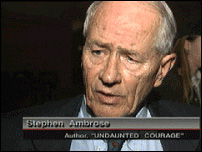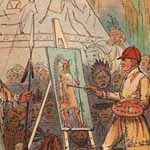
Credits & Sources
This exhibition was made possible thanks to the research and contributions of many individuals at the Library of Congress, The National Archives, and in the United States Senate, especially;
The Manuscript Division - Gerard Gawalt The Rare Book & Special Collections Division - Rosemary Plakas The Office of Information Technology Services - Lynn Brooks The Office of Library Services - Marney Canick The Office of Congressional Relations - Steve Kelley
The Democratic Technology & Communications Committee - Chris Casey |
| The Debates & Proceedings in the Congress of the United States. Seventh Congress, Second Session. Gales & Seaton, Washington, 1851. (image of cover page). |
| Documents of the Congress of the United States. American State Papers, Serials #7 & #16, Gales & Seaton, Washington, 1832. (image of cover page). |
 Stephen E. Ambrose. Undaunted Courage. Simon & Schuster, New York, 1996.
Stephen E. Ambrose. Undaunted Courage. Simon & Schuster, New York, 1996.
Stephen E. Abrose. Interview by Sen. Dorgan's staff 1997
Mr. Ambrose's book and the generous sharing of his time for an Interview with Sen. Dorgan's staff both have proved to be invaluable resources in the creation of this web site.
|
| Frank Bergon, Editor. The Journals of Lewis & Clark. Penguin Books, New York, 1989. |
 George Catlin. The Manners, Customs, and Condition of the North American Indians. London, 1841.
George Catlin. The Manners, Customs, and Condition of the North American Indians. London, 1841.
In an effort to discover and preserve the true character and customs of the North American Indians before their natural way of life disappeared, George Catlin spent the years 1832 through 1839 visiting 48 different tribes and recording his observations with brush and pen. He concluded that "the North American Indian in his native state is an honest, hospitable, faithful, brave, warlike, cruel, revengeful, relentless,--yet honourable, contemplative and religious being." Catlin spent three weeks with the Mandans in the summer of 1832, painting portraits of their chiefs, picturing village life, religious ceremonies, games and dances. Fascinated by the rituals and customs of this friendly and hospitable tribe, Catlin devoted nearly a quarter of his most important Indian work to the Mandans. |
| Dayton Duncon. Lewis & Clark: The Journey of the Corps of Discovery. Knopf, New York, 1997. The companion volume to the Ken Burns documentary. |
| "Captains Lewis and Clark, Returned" (portraits) William Fisher, comp. An Interesting Account of the Voyages and Travels of Captains Lewis and Clark. Baltimore, 1812. These are the portraits that are found on the entry page and in the header graphic on each of this exhibition's pages. These fanciful illustrations of Lewis and Clark were included in this spurious contemporary account compiled from Jefferson's 1806 message regarding the expedition, but supplemented by 18th Century reports of private travellers. |
| Patrick Gass. Journal of the Voyages and Travels of a Corps of Discovery, Under the Command of Capt. Lewis and Capt. Clarke . . . 3d. ed. Philadelphia, 1811. Reprinted by A. C. McClurg & Co., 1904. Patrick Gass, one of the three sergeants with the Lewis and Clark expedition, was the first member of the corps of discovery to publish his journal. Between its first printing in Pittsburgh in 1807, and the publishing of the journals of Lewis and Clark in 1814, Gass's account was the only one available to curious American and European readers. Editions of Gass's journal were published in London in 1808, in France in 1810 and in Germany in 1814. Mathew Carey published three editions in Philadelphia in 1810, 1811, and 1812 accompanied by six woodcuts, the first graphic illustrations of incidents described in Gass's journal. These woodcuts were often reprinted in later editions of both the Gass journal and the journals of Lewis and Clark. |
| Maximilian Alexander Philipp, Prinz von Wied-Neuwied. Travels in the Interior of North America. Leipzig, 192-? Facsimile plates. The Swiss artist Karl Bodmer accompanied Prince Maximilian's party on its travels up the Missouri River in 1832-34, retracing, in part, the route of Lewis and Clark. The Prince's scientific account of his trip was published in Coblenz, Paris, and London, between 1839 and 1843, accompanied by 81 copperplate engravings, based on Bodmer's watercolor paintings, that capture the first accurate depictions of North American Indian life and western landscapes. |
Documents from the National Archives and Records Administration
|